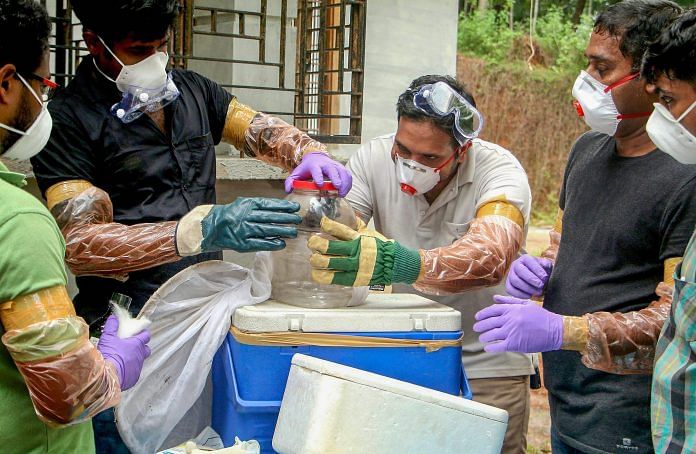New Delhi: After a 12-year-old boy succumbed to the Nipah virus in Kerala’s Kozhikode district Sunday, alarm bells were raised on the return of the infection that had left 17 dead in the state during an outbreak in 2018.
Health officials from the central government rushed to Kozhikode’s Chathamangalam village soon after, and met with the family of the deceased. They also collected samples of livestock and fruits to test them for Nipah.
Three years ago, the virus had hit the districts of Kozhikode and Malappuram, and at one point, around 3,000 people were under quarantine.
According to the World Health Organization, this was the first Nipah virus outbreak in South India. Two previous outbreaks were witnessed in West Bengal’s Siliguri (2001) and Nadia (2007) districts.
In 2019, a case had been reported in Kerala’s Ernakulam district, but it did not lead to any more cases or deaths.
ThePrint explains the symptoms and transmission of the Nipah infection, and the current situation in Kerala.
Also read: Ebola, Nipah and now Covid-19 — why bats transmit so many deadly viruses
About Nipah
A zoonotic virus, Nipah is transmitted from animals to humans and causes severe febrile encephalitis, a condition in which a person suffers from fever and an altered mental state.
The virus is usually found in fruit bats of the genus Pteropus, or in pigs. A 2006 paper, published in the journal Current Infectious Disease Reports, noted that deaths can occur in 40 to 75 per cent of Nipah cases.
“The first member of this genus to emerge was Hendra virus in 1994 in Australia,” according to the paper, titled ‘Nipah virus: Impact, origins, and causes of emergence’.
Following this, there was a large outbreak of the virus in 1998 and 1999 in Malaysia. The Nipah virus was also responsible for at least five outbreaks in Bangladesh between 2001 and 2005.
In Malaysia, most of the infections resulted from contact with pigs, while the outbreaks in Bangladesh and India were triggered by fruits or fruit products that had been contaminated by fruit bats.
Also read: If Ebola, Zika and Nipah can cross borders, so can technology. That’s where solution lies
Symptoms, transmission and diagnosis
Symptoms of the Nipah virus include fever, headache, cough, sore throat, difficulty in breathing, and vomiting. In more severe cases, patients can also feel disorientation, seizures, coma and brain swelling.
It can spread through direct contact with infected animals, consuming food products contaminated by infected animals, as well as close contact with an infected person or their body fluids, including respiratory droplets, urine, or blood.
Diagnosing the infection remains a challenge as the symptoms tend to be non-specific. A real-time polymerase chain reaction or RT-PCR test, which is the gold standard test for Covid-19, is typically used to detect the infection.
There are currently no treatments or vaccines available for the Nipah virus, with just intensive supportive care recommended to treat the infection symptomatically.
Current situation in Kerala
Officials from the Animal Husbandry Department were deployed to Chathamangalam village in Kozhikode district soon after the death of the 12-year-old boy to trace the origin of the virus. Samples were collected from livestock as well as fruits.
According to a report in Mathrubhumi, a goat at the boy’s house had also developed digestion issues, possibly indicating the presence of the Nipah virus. It is also suspected that a contaminated rambutan fruit could also be at the centre of the outbreak.
A timeline of the infection and a route map was also traced to determine the number of people that had come in contact with the child.
Authorities in Tamil Nadu have also been on alert, and screening has been stepped up in all the border districts.
Ma. Subramanian, Tamil Nadu’s minister for health and family welfare, said: “Already, we have been monitoring the nine districts that border Kerala. We have been conducting door-to-door awareness campaigns in the districts on the spread of Zika virus… In the wake of the Nipah virus, we have issued an advisory to district health officials to expedite measures like holding fever camps.”
(Edited by Rachel John)
Also read: What is scrub typhus, one of the infections suspected to be behind Firozabad ‘mystery’ deaths



